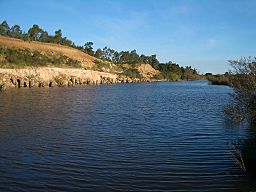Avon River (Gippsland, Victoria) facts for kids
Quick facts for kids Avon (Dooyeedang,Kutbuntaura-wurk) |
|
| River | |
|
On the Avon River near Stratford.
|
|
| Name origin: First called the Avoca; named the Avon by Angus McMillan | |
| Country | Australia |
|---|---|
| State | Victoria |
| Regions | South East Corner (IBRA), South East Coastal Plain (IBRA), West Gippsland |
| Local government area | Wellington |
| Part of | West Gippsland catchment |
| Tributaries | |
| - left | Turton River, Valencia Creek, Freestone Creek, Blackall Creek, Perry River |
| - right | Mount Hump Creek, McColl Creek, Ben Cruachan Creek, Navigation Creek, Nuntin Creek |
| Landmarks | Avon Wilderness Park, Gippsland Lakes |
| Source | Mount Wellington, Great Dividing Range |
| - location | Miller Spur, Avon Wilderness Park |
| - elevation | 664 m (2,178 ft) |
| - coordinates | 37°30′38″S 146°51′44″E / 37.51056°S 146.86222°E |
| Mouth | Lake Wellington |
| - location | east of Sale; southeast of Stratford |
| - elevation | 0 m (0 ft) |
| - coordinates | 38°2′57″S 147°16′7″E / 38.04917°S 147.26861°E |
| Length | 122 km (76 mi) |
| National park | Avon Wilderness Park |
The Avon River is a river in the West Gippsland area of Victoria, Australia. It's a "perennial" river, which means it flows all year round. When rain falls on the mountains of the Great Dividing Range, the water flows down the river and eventually reaches the beautiful Gippsland Lakes.
Contents
Where is the Avon River?
The Avon River starts on the southeastern slopes of Mount Wellington. This mountain is part of the Great Dividing Range. The river flows south, then east, then southeast. Finally, it reaches its end point, called its mouth, at Lake Wellington.
How long is the Avon River?
The Avon River is about 122 kilometres (76 miles) long. As it flows, it drops 664 metres (2,178 feet) from its source to its mouth.
What other rivers join the Avon?
The Avon River has ten smaller rivers and streams that flow into it. These are called tributaries. Some of its tributaries include the Turton River and the Perry River. The Latrobe River also flows into Lake Wellington. From Lake Wellington, the water then flows into Bass Strait through the Mitchell River.
What kind of land does the river flow through?
The top part of the river flows through the Avon Wilderness Park. This area is wild, with lots of forests and rugged land. After that, the river goes through hills covered in trees. Then it flows through open farmland. Near the town of Stratford, the river can be up to 500 metres (1,640 feet) wide. It flows over sand and pebble banks.
How is the river's water used?
There are no big dams on the Avon River. Most of its water is not used by people. Other nearby rivers, like the Latrobe and Thomson Rivers, provide drinking water for Melbourne. They also supply water for paper mills, power plants, and farms.
History and Indigenous Connection
The Avon River was very important to the Indigenous Gunai/Kurnai people. They are the traditional owners of this land.
The Bataluk Cultural Trail
About 3 kilometres (1.9 miles) south of Stratford is Knob Reserve. Here, you can find the Gunai/Kurnai Bataluk Cultural Trail. This trail follows the ancient paths used by the Indigenous people of East Gippsland for 30,000 years. It helps tell their stories and history.
What are the river's names?
In the Indigenous Australian Brataualung language, the river has two names. One name is Dooyeedang, but its meaning is not known today. The other name is Kutbuntaura-wurk. This name means "fire carriers" and wurk, which means "land" or "country".
The explorer Thomas Mitchell first called the river the Avoca River. Later, around 1840, Angus McMillan named it the Avon.
See Also


